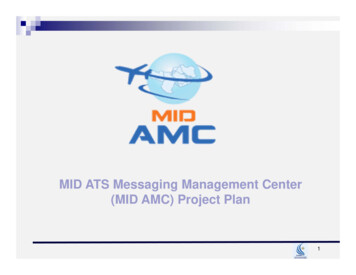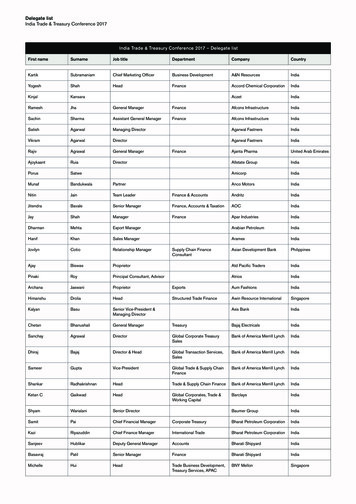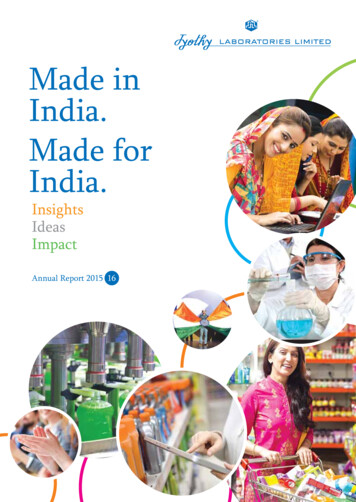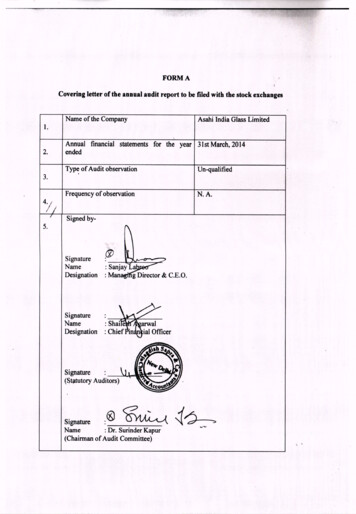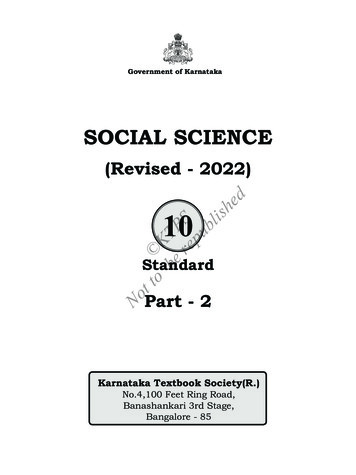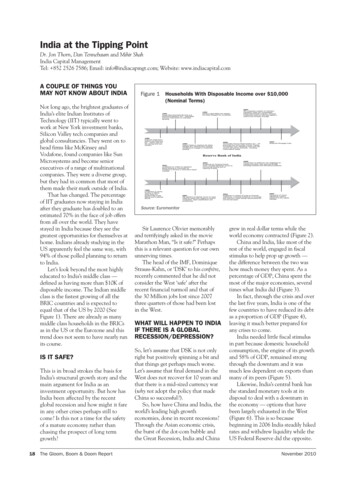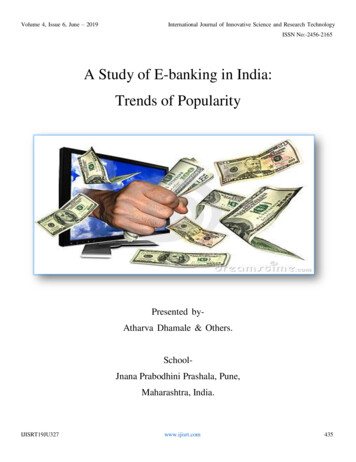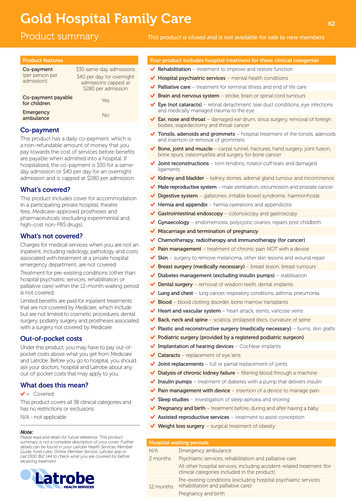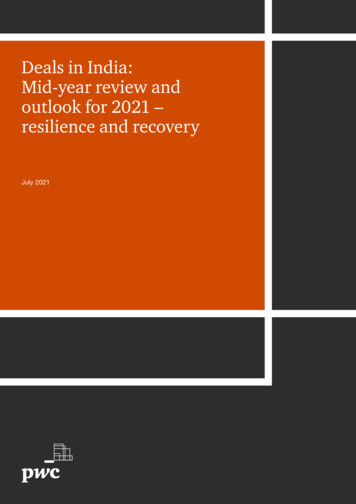
Transcription
Deals in India:Mid-year review andoutlook for 2021 –resilience and recoveryJuly 2021
2 PwC Deals in India: Mid-year review and outlook for 2021 – resilience and recovery
Deals in India:Mid-year review and outlook for2021 – resilience and recoveryThe COVID-19 pandemic caused significant uncertainty in 2020, furthercompounded by global trade tensions, regulatory pressures, geopolitical issuesand the US presidential transition. However, deal activity in 2020 nearly retainedmomentum with the previous year despite these challenges.The investor community was optimistic about recovery and stability in 2021,hoping that the worst of the pandemic was over. However, a second wave ofinfections resulted in lockdowns across states, thereby hampering ongoingdeal activities. Despite the impact, deal activity in H1 2021 (refers to the periodfrom 1 January 2021 to 15 June 2021) amounted to USD 40.7 billion across710 deals, including both private equity (PE) and strategic acquisitions (M&A).Various timely policy and credit measures announced by the Governmentof India (GoI) to revive the economy and make it more resilient, and a stablebanking system, have resulted in the growth of positive sentiments within theinvestor community.Key themes emerging in 2021 due to the uncertainty are – growing divergencein asset valuations, the acceleration of deals in digital and technology, andincreasing attention to environmental, social and governance (ESG) matters.3 PwC Deals in India: Mid-year review and outlook for 2021 – resilience and recovery
Deal activity in India102694380675571047.241.239.833.823.417.8H1 201926.117.712.521.321.122.1H2 2019H1 2020H2 2020PE deal value (in USD billion)M&A deal value (in USD billion)40.714.426.3H1 2021Total number of dealsSource: Venture Intelligence (PE), VCCEdge (M&A) and PwC analysisThe deal value of USD 40.7 billion recorded in H1 2021 was 2% higher than H2 2020 when deals worth USD 39.8 billionwere recorded despite the unstable economic environment. However, the deal value in H1 2021 was 14% lower comparedto the same period last year. The volume of deals recorded in H1 2021 has declined by 12% and 6% compared to H22020 and H1 2020 respectively.PE activity in H1 2021 was at an all-time high at USD 26.3 billion, 19% and 25% higher compared to H2 2020 and H12020 respectively. The surge in deal activity was fuelled by billion-dollar buyouts and numerous large fundraising rounds bystart-ups, boosting many of them into the unicorn club. PE investors are also shifting their focus towards sectors such astechnology and healthcare which show stronger potential for growth. M&A activity remained tepid yet operational largelydue to the few mega outbound deals that were recorded in H1 2021.4 PwC Deals in India: Mid-year review and outlook for 2021 – resilience and recovery
Upward swing of outbound dealsH1 2021 was marked by the dominance of billion-dollar outbound deals. Inbound deal activity continued its downwardtrajectory, amounting to only USD 0.5 billion in H1 2021 (4% of total M&A activity). Inbound activity peaked primarily in2020 because of the Reliance Group deals.Adani Green’s acquisition of SB Energy India for USD 3.5 billion was the largest deal recorded in H1 2021. The numberof deals recorded in the renewable energy space increased in this period. Wipro was also one of the major contributorstowards high-value outbound deals with the acquisition of UK-based Capco at USD 1.45 billion. Excluding these billiondollar deals, outbound activity amounted to USD 385 million across 26 deals.M&A activity by deal .58.714.42.35.38.99.48.85.22.7H1 2019H2 2019Inbound6.20.5H1 2020DomesticH2 2020OutboundH1 2021OtherSource: VCCEdge and PwC analysisCash-rich Indian businesses and lower interest rates have enabled corporates to engage in overseas acquisitions,especially that of established businesses. This trend is expected to continue as companies are on the lookout forscaling operations in international markets, acquiring complementary business capabilities and filling the gaps in theirexisting portfolios through acquisitions at lucrative valuations.5 PwC Deals in India: Mid-year review and outlook for 2021 – resilience and recovery
Consolidation continues to drive M&AM&A activity by deal type in H1 202116%The M&A deals space continues to be dominated bydomestic deals with activity worth USD 6.2 billion beingrecorded in H1 2021.43%InboundDomesticOutboundOther37%Domestic deal activity was driven by a few big-ticketdeals, the largest of them being the USD 1 billionacquisition of Aakash Educational Services by Byju’s.Adani Ports was also a major contributor towards bigticket deals, acquiring 89.6% stake in Gangavaram Portfor USD 755 million to further expand their logisticsnetwork.India Grid Trust completed the largest transmission-projectdeal by acquiring NER-II Transmission from Sterlite Powerat USD 637 million.4%Source: VCCEdge and PwC analysisAs evident, consolidation continues to be a standout trend.M&A value vs volume in H1 2021M&A deal volume (number of deals)31%217%6020%21472%M&A deal value (in USD billion)Deal size6.0Billion-dollardeals41%6.2USD 100 million– 1 billion43%2.0USD 10– 100 million USD 10million14%0.22%Source: VCCEdge and PwC analysisAlthough the three billion-dollar deals alone accounted for USD 6 billion in H1 2021, the majority of the M&A deal valueswere driven by smaller-ticket deals in the USD 100 million–1 billion bracket and totalling to USD 6.2 billion.6 PwC Deals in India: Mid-year review and outlook for 2021 – resilience and recovery
IPO market –recovery and rallyIndian companies raised INR 27,417 crore throughIPOs in H1 2021, the highest in at least a decadecompared to the first six months of previous years.1This was propelled by a strong bull run backed byGovernment incentives, liquidity, lack of alternativeinvestment opportunities, low interest rates and theanticipation of a sharp corporate performance postrecovery from the second wave. The key factorsresponsible for this surge include higher institutionaland retail investor participation, soaring valuationsand numerous high-performing stocks in selectsectors such as pharmaceuticals and technology.These were further supported by large institutionalplayers pouring unutilised funds from the previousyear into the market. SEBI has also eased the normsfor start-ups, minimum public offer and requiredpublic shareholdings for large issuers, leadingcompanies to explore -years-101625102879773-amp.html?utmcampaign fullarticle&utm medium referral&utmsource inshorts7 PwC Deals in India: Mid-year review and outlook for 2021 – resilience and recovery
PE activity at an all-time highPE activity kept the momentum going in H1 2021 and recorded deal value worth USD 26.3 billion, up by 19% and 25%from H2 2020 and H1 2020 respectively. The PE deal value in H1 2021 surpassed the previous comparable periods in 2020in spite of the large deals closed by the Reliance Group last year, totalling to USD 17.3 billion.Growth capital versus buyoutsH1 2021 was a standout period for buyouts. The two significant buyout deals recorded in H1 2021 were Piramal Group’sUSD 5.2 billion investment in the debt-ridden Dewan Housing Finance2 and Blackstone’s USD 2.8 billion investment inMphasis, a leading IT services provider in cloud and digital solutions.PE investments by stage25417161 65 50 41 5328 16 17 16 189.68.73.3Growth0.70.60.41.020190.5H1 H2 H1 H2 H1LateDeal value (in USD billion)0.8H1 H2 H1 H2 H120202021202020212020H1 H2 H1 H2 H12019H1 H2 H1 H2 H1Early1.71.320190.6201920212020202020192019H1 H2 H1 H2 H14.53.320190.70.76.0 6.2201920203.8201920204.520204.07.06.35.816 14 13 11 14Buyout2020202112.7201920201962021143 144 12712297235223PIPEDeal volumeSource: Venture Intelligence and PwC analysisExcludes real estate, pre-IPO and othersGrowth-stage deals also picked up in H1 2021, outperforming comparable periods from previous years. H1 2020 was anoutlier owing to the USD 9.8 billion marquee fundraising rounds by the Reliance Group (Jio Platforms). Big-ticket deals inH1 2021 saw 17 companies raise funds in the range of USD 100–500 million, contributing to 58% of the deal value andhelping start-ups like Meesho, PharmEasy and ShareChat enter into the unicorn club. Smaller-ticket deals accounted for themaximum number of investments and contributed to 86% of the deal activity by volume.Small-ticket deals drove the bulk of early-stage investments with 75% of them valued at less than USD 5 million andfocusing towards India’s booming technology sector start-ups. The remaining 43 deals were in the range of USD 5–20 millionand were largely recorded by EdTech and FinTech start-ups.Late-stage deals recorded in H1 2021 also performed well with large fundraising rounds by start-ups such as the EdTech firmByju’s’ USD 785 million fundraise and the food delivery platform Swiggy’s USD 800 million fundraise. An increased numberof private investment in public equity (PIPE) deals was recorded and primarily driven by the fundraising round led by Carlylein PNB Housing Finance. However, the Securities and Exchange Board of India (SEBI) has currently put this deal on hold.2Piramal sold its main business (pharma) to Abbott in 2010, after which they have been actively involved only in investments inother companies. Since their activities are similar to those of a holding company or a fund, this deal is classified as under PE.8 PwC Deals in India: Mid-year review and outlook for 2021 – resilience and recovery
Megadeals – buyers go bigLarge strategic investments or takeovers continued to dominate the deals space in 2021. Corporate and private acquirershave carried on with their pursuit of megadeals and five billion-dollar deals have already been recorded in this year.M&A megadeals in sectors such as renewables, infrastructure and education reflect the continued interest in consolidation.PE funds have demonstrated their faith in India’s growth story and made long-term investments despite the pandemic. TheIndia-centric dry powder has helped PE funds, and established companies with greater liquidity are expected to recordmore big-ticket deals.Top five M&A transactions (by deal value) in H1 2021Deal value(in USD billion)% soughtAdani Green Energy Ltd.3.5100The Capital MarketsCompany N.V.Wipro Ltd.1.5100Aakash EducationalServices Ltd.Think and Learn Pvt. Ltd.1.0100Gangavaram Port Ltd.Adani Ports and Special Economic Zone Ltd.0.889.60NER II Transmission Ltd.India Grid Trust0.6100CompanyBuyer(s)SB Energy Holdings Ltd.Source: VCCEdgeTop five PE transactions (by deal value) in H1 2021Deal value(in USD billion)%soughtPiramal Enterprises5.2-MphasiSBlackstone2.8-SwiggyThink Investments, Wellington Management, ProsusVentures, Qatar Investment Authority, Falcon EdgeCapital, Amansa Capital, Accel India, GIC and others0.817.47Byju’s ClassesFootpath Ventures, B Capital Group and others0.8-Embassy Industrial ParksBlackstone0.7-CompanyBuyer(s)Dewan Housing FinanceSource: Venture Intelligence9 PwC Deals in India: Mid-year review and outlook for 2021 – resilience and recovery
The SPAC factorIndia has one of the world’s largest start-up ecosystems withover 40,000 start-ups and 50 unicorns. There is a tremendouspotential for striking cross-border deals and special purposeacquisition companies (SPACs) could provide a boost toentrepreneurship by enabling access to capital. The de-SPACingprocess is, at times, financially cumbersome for founder/promoter shareholders. However, like the real estate investmenttrust (ReIT) and infrastructure investment trust (InvIT) regime, taxreforms can help in accelerating cross-border deals in the SPACspace. It would be interesting to see how India’s regulatorybodies administer and govern SPACs – especially their listing –which is presently not s/deals/rise-of-spacsan-indian-perspective.pdf10 PwC Deals in India: Mid-year review and outlook for 2021 – resilience and recovery
Technology in the leadThe technology sector dominated the PE investments space with 16 start-ups entering the unicorn club in 2021 comparedto 9 in 2020.4 EdTech is the emergent sector as major players like Byju’s and UpGrad continue to raise funds.Top five sectors attracting PE investments (in USD alservices2.62.21.4Real estate1.31.0Healthcare andlife sciences0.81.16.83.62.12.11.5H1 20210.3Education0.10.90.7H2 2020H1 20201.1H2 2019H1 2019Source: Venture IntelligenceThe deal value recorded in the financial services sector also increased significantly due to the stressed-asset investmentby the Piramal Group in Dewan Housing Finance.The healthcare and life sciences sector also continued to garner interest and witnessed a jump in deal activity. This surgewas primarily due to Manipal Hospitals engaging in two fundraising rounds totalling to USD 435 million.The real estate sector deal activity was led by Blackstone’s purchase of Embassy Industrial Parks from WarburgPincus and Embassy Group for USD 715 million. This acquisition was one of the largest deals in India’s emergingwarehouse -Unicorn-Tracker.php11 PwC Deals in India: Mid-year review and outlook for 2021 – resilience and recovery
The new unicornsThe Indian start-up ecosystem has grown consistently in recent years, especially in the technology sector. Newer-agecompanies are leveraging innovative technologies such as artificial intelligence (AI), internet of things (IoT), big data anddeep consumer insights to disrupt targeted pockets in various industries such as FinTech, e-commerce and education.Several start-ups have managed to accelerate through their natural growth cycle, quickly crossing their inflection point andmonetising their businesses.Stricter foreign direct investment (FDI) norms have also provided an impetus to India-based start-ups and helped them togrow and leverage the market. The COVID-19 pandemic has accelerated the adoption of digital technology across sectorsand Indian start-ups are establishing and strengthening their presence in the new normal.The following start-ups have entered the unicorn club in 2021:5CompanySectorBrowserStackSaaS – programming tools and testingChargeBeeSaaS – subscription billing solution1.4CredPayments – credit card rewards2.2DigitInsurance – general1.9FirstCryE-commerce2.1Five Star Business FinanceNon-banking financial company1.4GrowwPersonal finance – mutual funds1GupshupConversational messagingInfra.MarketMarketplace – construction materialsInnovaccerData analytics ‒ healthcare1.3MeeshoSocial commerce2.1MoglixMarketplace – industrial equipment1PharmeasyE-pharmacies4ShareChatSocial media2.1Urban CompanyMarketplace – handyman services2.1ZetaAPI – financial services and banking1.4Source: Venture Intelligence and PwC n-Unicorn-Tracker.php12 PwC Deals in India: Mid-year review and outlook for 2021 – resilience and recoveryValuation (in USD billion)41.41
Strategic sales boost exits for PE playersPE exit activity4437 3719138Strategic saleExit value (in USD billion)Buyback-1-2021H1 H2 H1 H2 H12020202020202019Public market saleH1 H2 H1 H2 H10.2 0.1 -20200.20.50.120191.6H1 H2 H1 H2 H1201920212020Secondary sale1 -3.10.2H1 H2 H1 H2 H1202020192019202020202021H1 H2 H1 H2 H11.31.00.70.620190.20.020190.60.72.5 1.81.7 1.74 320193.68 86 5202119202017202010.230 302019253131201933 32202133OtherNumber of exitsSource: Venture Intelligence and PwC analysisPE exits increased exponentially in H1 2021 at 5.4 times the exit value of H2 2020. Strategic sales accounted for 58% ofthe exit value in H1 2021 mainly due to two billion-dollar exits where Hitachi acquired GlobalLogic from Partners Groupand the Canada Pension Plan Investment Board for USD 8.1 billion, and Tata Digital acquired BigBasket from Abraaj Groupand Alibaba for USD 1.2 billion.Secondary sales accounted for 21% of H1 2021 PE exits as deal value witnessed a 3.6-times jump from H2 2020. Keyexits included Warburg Pincus selling off its stake in Embassy Group to Blackstone and ChrysCapital exiting Infogain, theSilicon Valley based IT services firm.Public market transactions contributed to 18% of H1 2021 PE exits, driven by a few transactions at the USD 500 millionrange with PE players such as Goldman Sachs and Carlyle exiting portfolio companies such as ReNew Power, SBI Cardsand SBI Life Insurance.The PE exit boom can be attributed to the fulfilling of pent-up demand from the previous year, increasing M&A activity inthe start-up ecosystem, focusing on consolidation in the technology sector with improved liquidity and the recent reboundand remarkable performance of the Indian stock market.13 PwC Deals in India: Mid-year review and outlook for 2021 – resilience and recovery
ESG – driving the next wave of transformationFindings from PwC’s 24th Annual CEO survey indicate that addressing the issue of climate change isa significant priority for 30% of global CEOs. As per the survey, 28% of Indian CEOs explicitly statethat they are factoring in climate change and environmental issues in their strategic risk-managementactivities. Compared to 39% of global CEOs, 40% of Indian CEOs believe that their organisationsshould be more responsible towards measuring the environmental impact and value of their businessactivities. Similarly, compared to 25% of global CEOs, 23% of Indian CEOs believe that they need totake further actions to measure their ESG impact on wider communities.6CEOs worldwide are also pushing for greater reporting on how their organisations are performingon the ESG front. They are looking to reorganise their businesses and focusing on improving theirperformance to utilise some of the increasing capital inflows as ESG funds since governments andinvestors are increasingly preferring that organisations become more environmentally .pdf14 PwC Deals in India: Mid-year review and outlook for 2021 – resilience and recovery
Five years of the Insolvency andBankruptcy Code (IBC), 201674,376Corporate insolvency resolution process3,8772,6532,0391,8381,89974337136As on Mar '178365371,7231,063206As on Mar '18As on Mar '19AdmittedClosureAs on Mar '20As on Mar '21OngoingSource: Insolvency and Bankruptcy Board of IndiaThe IBC provisions came into force on 1 December 2016. Since then, a total of 4,376 corporate insolvency resolutionprocesses (CIRPs) under the IBC have been initiated till March 2021 and 2,653 of them have been closed till date. Out ofthe closed CIRPs, 617 have been closed on appeal/review/ settlement, 411 have been withdrawn, 1,277 have ended inorders for liquidation and 348 have ended in approval of resolution plans.The pandemic significantly impacted the resolution of stressed assets cases and led to operational challenges for partiesinvolved in insolvency proceedings. Furthermore, the suspension of new proceedings under the IBC for almost a yearslowed the resolution process.IBC activity picked up in May–June 2021Insolvency issues involving the two large accounts of JetAirways and Videocon Industries Limited were reportedlyresolved in June 2021 by the National Company LawTribunal (NCLT).Dewan Housing Finance received approval from theNCLT on Piramal Group’s resolution plan amidst promoterlitigation. Real-estate major Suraksha Group securedconsent from the lenders for buying the townshipdeveloper Jaypee Infratech Limited.Meanwhile, the two large accounts of Reliance HomeFinance and Kingfisher Airlines were resolved outside ofthe insolvency framework.Modes of CIRP closure48%16%13%48%23%Commencement of liquidationAppeal/review/settledWithdrawal under Section 12AApproval of resolution planSource: Insolvency and Bankruptcy Board of 151b90.pdf15 PwC Deals in India: Mid-year review and outlook for 2021 – resilience and recovery
Outlook for the futureThe GoI has undertaken several key policy measures and reformsthroughout the pandemic to reinstate investor confidence and positionIndia as a preferred destination for investment, innovation and growth.The Production Linked Incentive (PLI) schemes across importantsectors, lowering of tax rates, extending the tax holiday for start-ups,loan moratoriums and initiatives to encourage micro, small and mediumenterprises (MSMEs) are some of the steps taken by the GoI in the recentpast. The GoI has also announced fast-tracking investment clearancethrough an empowered group of secretaries, a proposed public sectorenterprise policy, an electronics manufacturing clusters scheme, a newtariff policy in the power sector, private participation in the coal sectorand various other reforms. Despite the uncertainties, FDI equity inflowincreased by 19% in 2020–21 (USD 59.64 billion) compared to 2019–20(USD 49.98 billion).8The emphasis on Aatmanirbhar Bharat may boost investments forcompanies and help them in becoming self-reliant and reducingdependencies on imports. The privatisation of public sector undertakings(PSUs) is expected to attract a lot of investor interest.Digital transformation could remain a priority for many companies and isexpected to encourage healthy competition for acquiring the necessarybusiness infrastructure and forcing premium valuations. As per a recentPwC survey, 93% of the global business leaders said that they plan toallocate more resources towards digital transformation. Organisations areexpected to engage in more M&A activities in the technology/digital domainfor achieving their key strategic priorities.There could be increased transactions in supply-chain acquisitions ascompanies look to maintain control over the parts and inputs they require,and also lend the required flexibility.Players from sectors that contribute towards India’s infrastructure, suchas EdTech, FinTech, defence, pharmaceuticals and healthcare, have beenpropelled to reimagine the delivery mechanisms of their products andservices. It is expected that these players would look to become moreresilient in the future to create innovative solutions and a competitive M&Aenvironment.India’s growth story is expected to continue given the country’sdemographic dividend, favourable policies, reforms announced by theGovernment and new entrepreneurial talents and initiatives coming to thefore, especially in the start-up space. Deal activity is expected to garnerpace and record higher numbers in H2 merce-ministry/664512/Note: All deal values and related data presented in this report, unless otherwiseindicated, are based on PwC analysis of data sourced from VCCEdge (for M&Adeals) and Venture Intelligence (for PE deals).16 PwC Deals in India: Mid-year review and outlook for 2021 – resilience and recovery
About PwCAt PwC, our purpose is to build trust in society andsolve important problems. We’re a network of firmsin 155 countries with over 284,000 people whoare committed to delivering quality in assurance,advisory and tax services. PwC refers to the PwCnetwork and/or one or more of its member firms,each of which is a separate legal entity. Please seewww.pwc.com/structure for further details.Find out more about PwC India and tell us whatmatters to you by visiting us at www.pwc.inContact usDinesh AroraPartner and Leader, DealsPwC Indiadinesh.arora@pwc.comContributorsKanchana RamamurthiSue Ellen PereiraAbha TamhankarMuneer OmerEditorial supportSaptarshi DuttaDesignHarshpal Singh17 PwC Deals in India: Mid-year review and outlook for 2021 – resilience and recovery
pwc.inData Classification: DC0 (Public)In this document, PwC refers to PricewaterhouseCoopers Private Limited (a limited liability company in India having Corporate IdentityNumber or CIN : U74140WB1983PTC036093), which is a member firm of PricewaterhouseCoopers International Limited (PwCIL), eachmember firm of which is a separate legal entity.This document does not constitute professional advice. The information in this document has been obtained or derived from sourcesbelieved by PricewaterhouseCoopers Private Limited (PwCPL) to be reliable but PwCPL does not represent that this information is accurateor complete. Any opinions or estimates contained in this document represent the judgment of PwCPL at this time and are subject to changewithout notice. Readers of this publication are advised to seek their own professional advice before taking any course of action or decision,for which they are entirely responsible, based on the contents of this publication. PwCPL neither accepts or assumes any responsibility orliability to any reader of this publication in respect of the information contained within it or for any decisions readers may take or decide not toor fail to take. 2021 PricewaterhouseCoopers Private Limited. All rights reserved.HS/July2021 - 13716
M&A deal volume (number of deals) M&A deal value (in USD billion) 72% 20% 7% 1% 2% 43% 41%. M&A value vs volume in H1 2021. Although the three billion-dollar deals alone accounted for USD 6 billion in H1 2021, the majority of the M&A deal values . were driven by smaller-ticket deals in the USD 100 million-1 billion bracket and totalling to .
